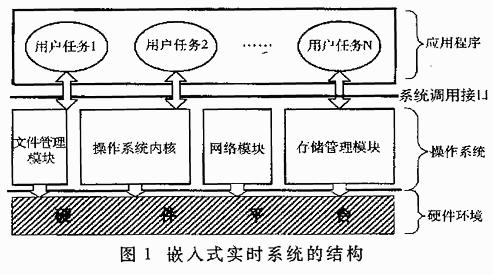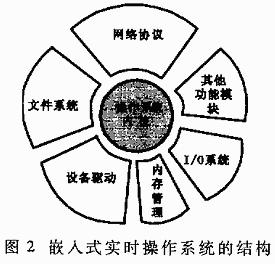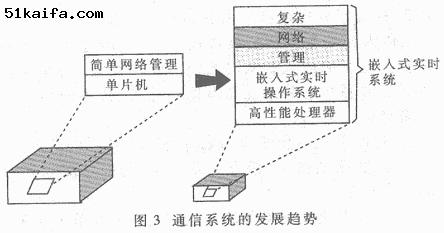Among the many branches of the IT industry, embedded is one of the fastest growing areas, because more and more products and services require the support of embedded systems. Many industries such as consumer electronics, manufacturing, office automation, industrial control, etc. are closely related to embedded.
As a new, application-oriented computer system, embedded systems not only integrate the common features of general-purpose computer systems, but also include many new technologies suitable for "embedded" applications. Because they are technically different from general-purpose computer systems, this article first introduces the basic concepts of embedded systems and their key technologies, and explains their technical characteristics and applicability in combination with their applications in communication systems.
1 Embedded Real-Time Systems
The embedded system includes one or more control CPUs and high-level software developed for a specific application environment, usually including an operating system. During use, the behavior of the CPU and software inside the system is not perceived by the outside world, so it is called an "embedded" system; embedded systems with a very short response time to external events are usually called "embedded real-time systems"; operating systems used in embedded real-time systems are called "embedded real-time operating systems."
1.1 Composition of Embedded Real-Time Systems
Embedded real-time systems include hardware and software, and consist of three parts: hardware platform, embedded real-time operating system and other system software modules, and real-time application programs, as shown in Figure 1.

1.1.1 Hardware Platform
The hardware platform of an embedded real-time system usually takes a compact and highly specialized CPU as the core and combines a small number of peripheral devices with application relevance, that is, diversity.
1.1.2 Embedded real-time operating system and other system software modules
The operating system and other system software are between the hardware and the application, responsible for scheduling and managing real-time applications and completing the control and operation of the hardware.
1.1.3 Real-time Applications
Real-time applications are applications that are based on embedded real-time operating systems and use the real-time mechanisms provided by the operating system to complete specific functions of specific embedded real-time systems.
1.2 Characteristics of Embedded Real-Time Operating Systems
In addition to the common characteristics of operating systems, in order to adapt to "embedded real-time" applications, embedded real-time operating systems also have outstanding features such as real-time performance, micro-kernel combined with expansion modules to achieve universality and configurability, and the operating system does not make assumptions about peripherals.
1.2.1 Real-time
Real-time means "timely", which is a relative concept; real-time performance indicates the operating system's ability to respond to and process external events within a foreseeable time, and is one of the key indicators of embedded real-time operating system performance. Embedded real-time operating systems generally use a multi-tasking mechanism to execute applications in a concurrent manner.
1.2.2 Microkernel combined with extension modules to achieve universality and configurability
In order to adapt to different "embedded" applications in terms of structure and function, embedded real-time operating systems usually adopt an architecture that combines a microkernel with configurable functional modules, making the operation both universal and configurable. The structure of an embedded real-time operating system is shown in Figure 2.

1.2.3 The operating system does not make assumptions about peripherals
The implementation of the operating system is only related to the CPU, and does not assume other physical hardware outside the CPU. Hardware-related functions rely on another software layer called the Board Support Package to complete, thus achieving the "hardware independence" of the operating system and improving the versatility and portability of the system.
1.3 Comparison between Embedded Real-Time Systems and General-Purpose Computer Systems
By comparing Table 1, we can see that embedded systems are application-centric, computer-based, software and hardware-customizable, and adaptable to application systems. They have strict requirements on functions, reliability, cost, size, and power consumption. They are dedicated computer systems.
Table 1 Comparison between embedded real-time systems and general-purpose computer systems

2 Implementation of Embedded Real-Time System
2.1 Selecting a suitable embedded real-time operating system
Embedded real-time operating system is the core of implementing embedded real-time system. The performance of operating system directly affects the real-time performance of the whole system to a large extent. Therefore, choosing a suitable embedded real-time operating system is crucial to realize a high-performance embedded system.
2.2 Carefully divide the tasks within the application
As another important software layer, the division of tasks within the application also affects the overall performance of the embedded real-time system. In order to take into account the concurrency and overall throughput of the embedded real-time system, the division of tasks should follow the following principles:
Functionally independent operations should be a single task;
Operations with close functional connections (close coupling) should be grouped into the same task;
Functions with slow I/O operations should be divided into separate tasks;
Different priority operations are divided into different tasks;
· Operations that are computationally intensive should be divided into a separate task.
2.3 Debugging of Embedded Real-Time Systems
Unlike the design of general computer systems, the design of embedded real-time systems always involves hardware factors, so debugging the hardware platform is a necessary step. In terms of software, since embedded real-time systems are usually multi-tasking systems with strong dynamics, the functional behavior of the system needs to be determined through debugging.
3 Application of embedded real-time systems in communication systems
As a special type of computer system, the application scope of embedded real-time system has expanded to many fields, especially in the field of communication, which has achieved unprecedented development. With the opening of new network services and the increase of new equipment, telecommunication network management has become an increasingly prominent issue and has attracted much attention.
The expansion of communication networks, the massive increase in new services and new equipment require network management to have not only rich management functions, but also good management performance and efficiency; that is, network management must meet certain real-time requirements. In short, modern network management has the following two outstanding characteristics:
·Complete management functions;
Good management performance.
In order to achieve complete and efficient network management, communication equipment must enhance its own performance, thus providing a high-performance software and hardware platform for high-level network management. A new development trend has emerged in the design of communication systems, as shown in Figure 3.

The main reasons for this trend are:
(1) The previous method of using microcontrollers as a platform and running applications directly on the CPU has obvious shortcomings:
Limited hardware capabilities, unable to perform efficient and complex device management;
The hardware platform is simple and cannot effectively support multi-functional and complex network management;
The software lacks support from the operating system, and the network application design is complex, making it difficult to achieve full-featured performance network management.
(2) General-purpose computers are not suitable for this application environment due to limitations in size, cost, and efficiency.
(3) Using embedded real-time systems is an ideal solution:
Embedded real-time systems use compact and efficient CPUs in hardware, which are suitable for being "embedded" inside devices as the hardware core of control and can support complex device management;
In terms of software, the embedded real-time system is based on a high-performance embedded real-time operating system, which not only provides good real-time guarantee for the system, but also simplifies the design of high-level application programs.
As a new field of computer application, embedded real-time system has attracted more and more attention due to its simplicity and high efficiency. As the application environment becomes more and more complex, the system requires more and more functions, and embedded real-time operating system has become an essential part of realizing embedded real-time system.
After rapid development in recent years, the application scope of embedded real-time systems has expanded to areas that were previously only available for general-purpose computer systems, and the number of applications has exceeded that of general-purpose computer systems, especially in the telecommunications and IT fields, where they have been used more widely than ever before.
The rapid rise of embedded real-time systems marks the arrival of the "Post-PC Era". Embedded systems are becoming the systems with the most development potential and application prospects after PCs. Their rapid development is becoming a new and powerful driving force for the rapid development of industries such as IT (including communications and information).
Previous article:Embedded microcontroller for controlling permanent magnet brushless DC motors
Next article:SD storage technology and its application based on S3C2410
- Popular Resources
- Popular amplifiers
-
 Mission-oriented wireless communications for cooperative sensing in intelligent unmanned systems
Mission-oriented wireless communications for cooperative sensing in intelligent unmanned systems -
 ICCV2023 Paper Summary: Fairness, Privacy, Ethics, Social-good, Transparency, Accountability in Vision
ICCV2023 Paper Summary: Fairness, Privacy, Ethics, Social-good, Transparency, Accountability in Vision -
 Introduction to Artificial Intelligence and Robotics (Murphy)
Introduction to Artificial Intelligence and Robotics (Murphy) -
 Embedded system development tips, a novice\'s growth log and a project manager\'s recipe
Embedded system development tips, a novice\'s growth log and a project manager\'s recipe
- Molex leverages SAP solutions to drive smart supply chain collaboration
- Pickering Launches New Future-Proof PXIe Single-Slot Controller for High-Performance Test and Measurement Applications
- CGD and Qorvo to jointly revolutionize motor control solutions
- Advanced gameplay, Harting takes your PCB board connection to a new level!
- Nidec Intelligent Motion is the first to launch an electric clutch ECU for two-wheeled vehicles
- Bosch and Tsinghua University renew cooperation agreement on artificial intelligence research to jointly promote the development of artificial intelligence in the industrial field
- GigaDevice unveils new MCU products, deeply unlocking industrial application scenarios with diversified products and solutions
- Advantech: Investing in Edge AI Innovation to Drive an Intelligent Future
- CGD and QORVO will revolutionize motor control solutions
- Innolux's intelligent steer-by-wire solution makes cars smarter and safer
- 8051 MCU - Parity Check
- How to efficiently balance the sensitivity of tactile sensing interfaces
- What should I do if the servo motor shakes? What causes the servo motor to shake quickly?
- 【Brushless Motor】Analysis of three-phase BLDC motor and sharing of two popular development boards
- Midea Industrial Technology's subsidiaries Clou Electronics and Hekang New Energy jointly appeared at the Munich Battery Energy Storage Exhibition and Solar Energy Exhibition
- Guoxin Sichen | Application of ferroelectric memory PB85RS2MC in power battery management, with a capacity of 2M
- Analysis of common faults of frequency converter
- In a head-on competition with Qualcomm, what kind of cockpit products has Intel come up with?
- Dalian Rongke's all-vanadium liquid flow battery energy storage equipment industrialization project has entered the sprint stage before production
- Allegro MicroSystems Introduces Advanced Magnetic and Inductive Position Sensing Solutions at Electronica 2024
- Car key in the left hand, liveness detection radar in the right hand, UWB is imperative for cars!
- After a decade of rapid development, domestic CIS has entered the market
- Aegis Dagger Battery + Thor EM-i Super Hybrid, Geely New Energy has thrown out two "king bombs"
- A brief discussion on functional safety - fault, error, and failure
- In the smart car 2.0 cycle, these core industry chains are facing major opportunities!
- The United States and Japan are developing new batteries. CATL faces challenges? How should China's new energy battery industry respond?
- Murata launches high-precision 6-axis inertial sensor for automobiles
- Ford patents pre-charge alarm to help save costs and respond to emergencies
- New real-time microcontroller system from Texas Instruments enables smarter processing in automotive and industrial applications
- Issues with converting remaining TI points into chip points
- Development process of eCAN in DSP28335
- Sugar gliders Part ⑩ Sugar glider health monitoring system based on RSL10 - host computer design
- Can someone help me figure out whether this active filter is a voltage-controlled power supply type or a multiple feedback type?
- 【BearPi-HM Nano】NFC test
- Frost has fallen~
- Summary by an expert: Answers to 23 classic questions in power supply development!
- What is the difference between these two ways of connecting the max680 capacitor?
- 2G/GPS/Bluetooth or Zigbee IoT communication module
- Application of ZigBee in intelligent management of production lines

 Mission-oriented wireless communications for cooperative sensing in intelligent unmanned systems
Mission-oriented wireless communications for cooperative sensing in intelligent unmanned systems ICCV2023 Paper Summary: Fairness, Privacy, Ethics, Social-good, Transparency, Accountability in Vision
ICCV2023 Paper Summary: Fairness, Privacy, Ethics, Social-good, Transparency, Accountability in Vision Embedded system development tips, a novice\'s growth log and a project manager\'s recipe
Embedded system development tips, a novice\'s growth log and a project manager\'s recipe











 京公网安备 11010802033920号
京公网安备 11010802033920号